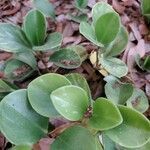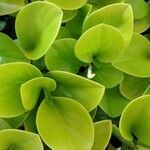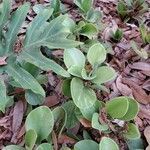Epiphytic, epilithic or terrestrial herb. Stem erect, creeping or ascending, rooting at nodes, glabrous, green or green with red spots. Leaves alternate, basely attached; petiole green or green with red spots, 1-6.5 cm long, more or less grooved, minutely pubescent; blade shiny green, pale green below, coriaceous, often with red spots, elliptic, obovate or subspathulate, 4-14.5 x 2.5-6.5 cm, apex rounded, obtuse or emarginate, base cuneate, glabrous; venation obvious or hardly visible, ca, 7-pli-veined, or few veins branching off primary vein. Inflorescence terminal, solitary or few together; both the common peduncle and those of individual spikes bracteate, green or pinkish, slender (when dried) or not slender, together 1-14 cm long, usually minutely pubescent; spikes to 18 cm long, greenish white to yellow, densely flowered; floral bracts rounded, 2-4 mm in diam., glabrous, glandular. Fruits basely attached, ellipsoid, verruculose, reddish brown or blackish, apex abruptly contracted into slender beak, which is curved or curled at tip, stigma at base of beak.
Herbs , perennial, rhizomatous, erect, decumbent, reclining, or somewhat scandent, simple or sparsely branched, 8-40 cm, mostly glabrous, without black, glandular dots. Leaves alternate; petiole 1/5-1/2, mostly ca. 1/3, length of blade, glabrous. Leaf blade highly variable in size and shape, prominently to obscurely pinnately veined, elliptic, broadly elliptic, or spatulate to ovate, obovate, or very broadly ovate or broadly obovate, 2.2-13 × 1.5-5.5 cm, lateral veins arching-ascending, originating from base to about middle of blade, base attenuate, mostly narrowly to broadly cuneate, rarely slightly acuminate, apex obtuse, rounded, retuse, or notched; surfaces mostly glabrous. Spikes mostly terminal, 1-2, densely flowered, 5.5-23 cm; peduncle with microscopic, spiculelike hairs, mature fruiting spikes 3.5-5.5 mm diam. Fruits sessile, ellipsoid, both ends rounded, 0.8-1.1 × 0.4-0.5 mm, faintly longitudinally striate; beak elongate, 0.5-0.7 mm, filiform above narrowly to broadly conic base, straight or S-shaped, abruptly hooked near apex.
A fleshy, stoloniferous-assurgent, terrestrial or epiphytic herb, glabrous except for the peduncle which is minutely hirtellous as is also sometimes the lower leaf-surface; stem up to 5 mm. thick when dry, ascending to 15 cm. or more from the prostrate, rooting base, internodes mostly 2-3 cm. long; leaves alternate, elliptic-obovate, 3-8 cm. wide X 5-20 cm. long, occasional specimens with smaller leaves, but commonly about 4-6 X 8-12 cm., apex rounded, obtuse, sometimes slightly emarginate, base cuneate, 7-to 11-plinerved from below the middle, the midrib branched upward, drying more or less coriaceous, opaque; petiole mostly 1.5-4
cm. long, or occasionally somewhat longer, more or less winged by the decurrent blade; spikes 2-4 mm thick X 5-15 cm. long, densely flowered, solitary or paired on a 1-bracted, terminal, leaf-opposed, or occasionally axillary, usually minutely hirtellous stalk 3-5 cm. or more long; floral bracts 0.3-0.4 mm. wide, round-peltate; fruit ellipsoidal, about 1.25 mm, long including the slender, erect, terminally hooked beak, stigma anterior at the base of the beak.
A fleshy herb. It can be erect or sprawling. The stems are 15 cm long. They take root at the nodes. The leaves are oval and 10 cm long. They are thick and alternate. They have rounded tips and wedge shaped bases. They are on winged stalks. This species varies a lot and is difficult to identify from others.




